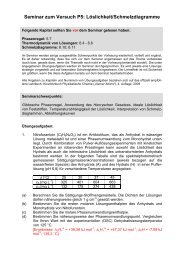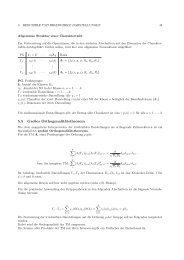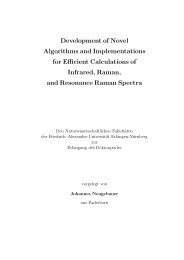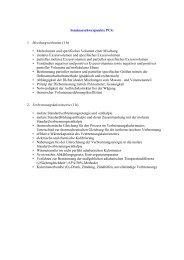Short documentation of the program (PDF)
Short documentation of the program (PDF)
Short documentation of the program (PDF)
Create successful ePaper yourself
Turn your PDF publications into a flip-book with our unique Google optimized e-Paper software.
1 Theory<br />
The central idea is to add in a semi-empirical fashion an energy correction ∆EgCP to <strong>the</strong> energies<br />
<strong>of</strong> molecular systems in order to remove artificial overbinding effects from BSSE. 1 As <strong>the</strong> focus lies<br />
on <strong>the</strong> contribution <strong>of</strong> individual atoms a natural outcome is its ability to yield also intramolecular<br />
BSSE corrections. The parametrization is constructed such that it approximates <strong>the</strong> Boys and<br />
Bernadi 2 counterpoise (CP) correction ∆ECP in <strong>the</strong> intermolecular case<br />
∆ECP ≈ ∆EgCP , (1)<br />
where e.g. for a complexation reaction A + B → C our correction is given by<br />
∆EgCP = EgCP (C) − EgCP (A) − EgCP (B) . (2)<br />
In practice, EgCP can simply be added to <strong>the</strong> HF/DFT energy<br />
The central equation over all atoms N reads:<br />
where <strong>the</strong> energy e miss<br />
a<br />
Etotal = E HF/DF T + EgCP . (3)<br />
EgCP = σ ·<br />
N∑<br />
a<br />
N∑<br />
b̸=a<br />
e miss<br />
a · fdec(Rab) , (4)<br />
is a measures for <strong>the</strong> incompleteness for <strong>the</strong> chosen target basis set (that<br />
is typically small), and fdec(Rab) is a decay function that depends on <strong>the</strong> inter-atomic distance<br />
Rab.<br />
The scaling factor σ is one out <strong>of</strong> 4 parameters needed for every / combination.<br />
Small basis sets show not only a large BSSE, but general shortcomings. These effects are not<br />
always clearly distinguishable. If computationally affordable, large basis sets (triple-ζ and higher)<br />
are always preferable for a given system.<br />
2 Quick Start<br />
Download <strong>the</strong> tarball from <strong>the</strong> homepage. 3 After unpacking <strong>the</strong> tarball, simply call make.<br />
The Intel compiler ifort and <strong>the</strong> GNU compiler gfortran are semi-automatically detected. If you<br />
prefer a different compiler edit <strong>the</strong> Makefile according to your liking. The code should (and must!)<br />
compile without any errors.<br />
The <strong>program</strong> can be invoked by typing<br />
gcp [-options]<br />
The coordinates can be given in Turbomole (unit = a.u.) or XMOL (unit = ˚A) format.<br />
3 Changelog<br />
V 1.04<br />
BUG : def2-SVP had wrong parameters for Li,Na,Mg,K. They have been updated. The old<br />
parameters set is available as svp old, eg. gcp coord -l hf/svp old<br />
added basis sets: sv(p) (=def2-SV(P)) and sv.x (def2-SV(P/h,c) which means no polarization<br />
fkts on H and C) eg: gcp coord -l ”dft/sv(p)” (<strong>the</strong> ” ” are important)<br />
2







